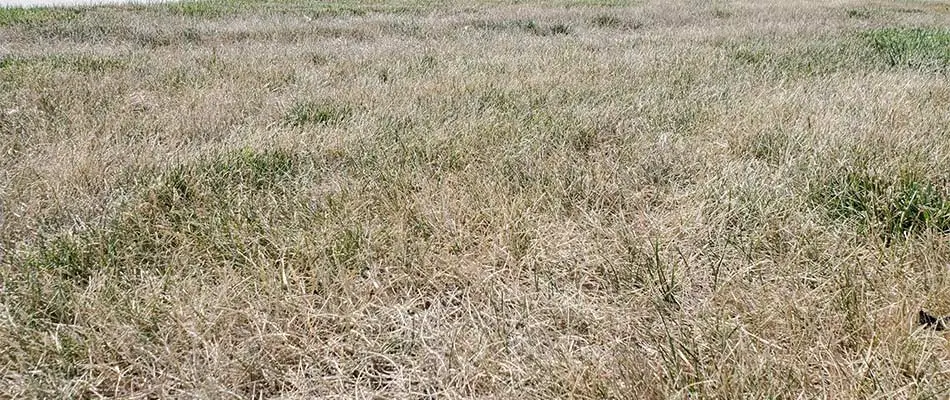Summer. It’s the thing that memories are made of. Popsicles on hot days, bare feet on sand, and hours, days of freedom. Bike rides, blowing dandelions, long vacations; summer causes time to seemingly stand still.
While summer can call to mind memories of days past, it also brings up practical things that our free, young, summer-loving selves would never have thought to consider. One of those practical matters is the effect that the heat of summer has on cool grasses. For property owners, this can be a huge concern.
Without the right knowledge and without taking the proper measures, your landscaping can suffer under the strain of summer sunlight and heat. The sunlight warms the air and the topsoil when it hits the ground, which has an impact on grass seed germination. While this doesn’t pose an issue for warm-season grasses, cool-season grasses can be directly impacted.
Cool Season Grasses
Typically, cool-season grasses are planted in the autumn. Their growth flourishes in ground temperatures of 50 to 65 degrees Fahrenheit, typically springing up in abundance in the spring. Cool-season grasses are dependent upon a great deal of rain and medium soil temperatures, making spring an ideal time of growth.
During the summer, with temperatures rising above 90 degrees, cool-season grasses fall dormant. While they are dormant, the grass tends to look brown, causing a bit of alarm for property owners. However, with proper irrigation and care by Sharp Lawn Care, as the soil temperature begins to change after the heat of the summer, the grass begins to grow and flourish again.
Cool-Season Grass Temperatures
Understanding cool-season grasses help to keep them cared for and properly maintained. Temperatures tend to have a large effect on these grasses, causing them to either flourish or fall dormant.
Soils that are 50-65 degrees provide the best temperature for root growth, while temperatures of 60-75 degrees provide the best temperature for shoot growth. During the summer, when temperatures rise, atmospheric and soil temperatures become too hot for cool-season grasses to grow and flourish. Once temperatures reach 77 degrees, it becomes too hot for root growth, and root growth ceases. When temperatures reach 90 degrees, it becomes too hot for shoot growth and the grasses stop growing and begin to fall dormant, with the surface grass turning a brown hue.
In the summer, you will want to keep an eye on your soil temperature (Here’s a soil thermometer). When it reaches 77-80 degrees in the first inch between the blade and the root, growth stops. As temperatures climb higher, the death of the grass begins.
You can be aware of soil temperatures even without a soil thermometer. Street temperatures of 100 degrees cause a turf temperature of 75 degrees. Sharp Lawn Care can help you determine your soil temperatures and provide the care you need to help your lawn through the hot season.
Caring for Your Cool-Season Grass Through the Summer
If your summer temperatures are going to rise above 95 degrees, or if you will be having high winds for a long portion of the day, you will want to lightly sprinkle your lawn with water from 11 am and 2 pm. Here’s a programmable water timer that can help.
These light sprinkles are used to cool the grass off through evaporation. This prevents the surface from getting too hot and suffering permanent damage, which could cause your lawn to be invaded by weeds.
You can automatically provide these light sprinkles for your lawn by setting your sprinkler system to go in short spurts multiple times during that period. Continue with regular watering as well.
Sharp Lawn Care recommends not using light, frequent irrigation for your lawn under normal conditions, as it can create more stressful situations in the heat. This type of irrigation causes very short functional roots.
When the extreme temperatures hit, the last remaining roots have excessive work to do in order to provide water for the plant and cool it off. As they work extremely hard during the heat, the short roots that are caused by light, frequent irrigation typically cannot keep up. This causes heat damage to occur which can cause the plant to die.
Recovering Your cool Seasonal Grass After Heat Stress
If your lawn suffers the effects of heat stress, you will want to increase your watering days and duration, skip a week of mowing, or contact Sharp Lawn Care. They will diagnose your lawn’s needs and provide the care that it needs so it can begin to grow and flourish again.
In the meantime, there are a few things that you can do to start bringing life back to a cool-season grass lawn damaged by the summer heat:
- Use kelp-based amendments.
- Keep your mow height to at least 4 inches.
- Overseed your lawn in the early fall using turf-type tall fescue, as it is cool season grass with a great deal of resilience.
Once your cool-season grass has been damaged, you’re going to want to bring it back to health. Contact Sharp Lawn Care today for your free quote. Your lawn can live again with Sharp Lawn Care.
We’ve linked tools and products in this article that may help you complete this work yourself. As an Amazon Associate, we earn from qualifying purchases.




Comments (0)
Thanks for your comment!
Thanks for your feedback! Your comments have been successfully submitted! Please note, all comments require admin approval prior to display.
Error submitting comment!
There is a problem with your comment, please see below and try again.